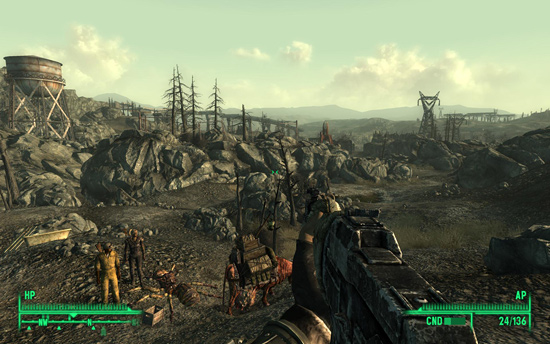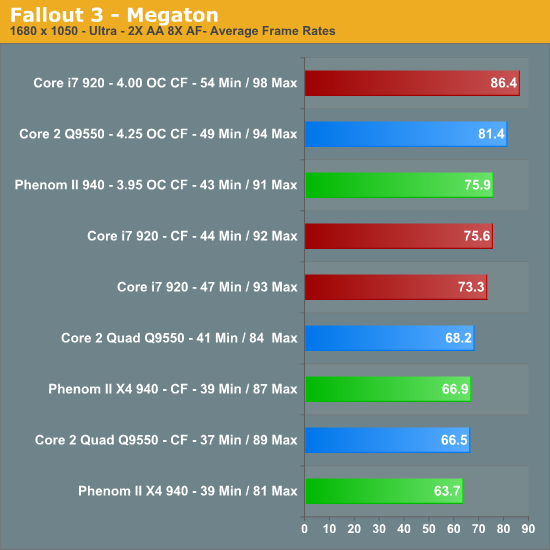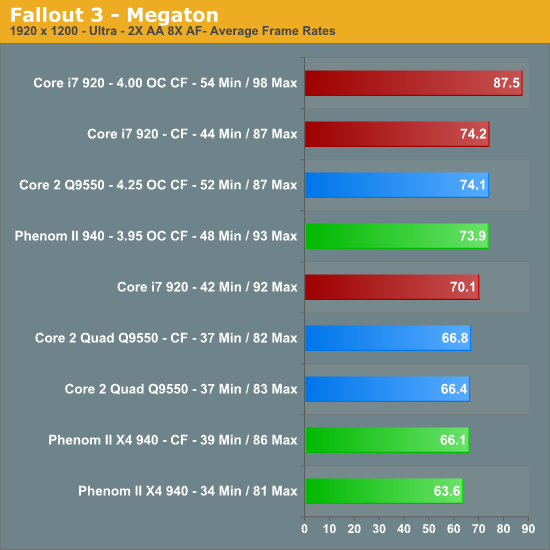CrossFireX and the Phenom II X4 940 – Competitive or Not?
by Gary Key on February 2, 2009 12:00 AM EST- Posted in
- Motherboards
Fallout 3

We have played this game numerous times and still have not visited every location on the map or completed all seventy or so side-quests. It could be that the game’s ambiance does not seem to match its predecessors. Alternatively, maybe some of the bugs present that result in NPC characters disappearing have us longing to play Oblivion or KOTR again. Even so, we still love the game. We have moved on to playing the new content pack, Operation: Anchorage, until Dragon Age: Origins ships.
The game engine is based on the one utilized in Oblivion with a few updates, so performance is similar. We set the quality settings to Ultra, AA to 2x, and AF to 8x. Our test consists of following a path back to Megaton and in the process fighting off a couple of Raiders. We utilize FRAPS to capture our results.

Truthfully, this game does not benchmark well. The game’s level-of-detail mechanism makes constant changes as you cross the map. The LOD adjustments create a seesaw effect in the frame rates and it is difficult to tell if the sudden pause or shudder in frame rates is from the video card or the game engine. That said, the Intel i7 platform simply performs best in this game.
Once again, in our single card testing at 1680x1050 each setup is very close with the Intel Q9550 holding a 4% advantage in average frame rates over the Phenom II 940. The Phenom II posts slightly better minimum frame rates once again. In CrossFire testing the Q9550 holds a small 1% advantage, close to our error of margin. The Q9550 picks up some steam when overclocked and holds an 8% advantage over the Phenom II 940 in average frame rates and 13% in minimum frame rates with a 7% clock speed advantage. The i7 leads our two competitors in overclocked CrossFire performance by 6% and 13% respectfully.
Adding a second card for CrossFire operation improves average frame rates by 4% and minimum frame rates stay the same for the Phenom II. The Intel Q9550 has an improvement of 2% in average frame rates and 11% in minimum frame rates. The Core i7 average frame rates improve by 3% and minimum rates decrease by 7%. Overclocking our processors resulted in a 14%~19% improvement in average frame rates with the Q9550 benefiting the most.

The 1920x1200 results are similar with the Q9550 and Phenom II 940 scoring nearly the same in single card and CrossFire. We just do not see any real benefits in having CrossFire at stock speeds with the Q9550 or Phenom II 940. Once we overclocked each processor, we noticed an 11% increase in CrossFire performance on these two platforms. The Q9550 holds a slight advantage in minimum frame rates with CrossFire when overclocked while the Phenom II 940 leads at stock clock speeds.
Adding a second card for CrossFire operation improves average frame rates by 4% and minimum frame rates by 15% for the Phenom II. The Intel Q9550 has an improvement of less than 1% in average frame rates and no changes in minimum frame rates. The Core i7 average frame rates improve by 6% and minimum rates increase 5%. Overclocking our processors resulted in a 12%~17% improvement in average frame rates with the Core i7 benefiting the most.
Our Core i7 scores better with a single card setup than the other two platforms with CrossFire. The same holds true with the stock i7 CrossFire results scoring higher than our two overclocked competitors do. Overclocking the i7 CrossFire setup results in a 17% increase in average frame rates that required a 50% increase in core clock speeds.
As far as game play experiences, we noted no differences between the Intel Q9550 and Phenom II 940 platforms. Each one offered a very good experience with minimum frame rates on each platform being acceptable. The amount of LOD adjustments in the game was disconcerting at times . When we experienced them, the game stutter was minimized on the i7 setup compared to the other two platforms with CrossFire enabled. All three platforms responded in the same manner with a single card setup. Overall, we would not recommend CrossFire for this game at present; even overclocking the processors resulted in a minimum improvement in frame rates.










68 Comments
View All Comments
megabuster - Monday, February 2, 2009 - link
If it's not too troublesome next time please include a few pictures of your hardware set up. :)none12345 - Monday, February 2, 2009 - link
There are errors in the benchmark charts on page 9....and maybe other pages..In the first chart you have the overclocked 9550 CF at the top of the chart, yet if you look at the min and max frame rates it is NOT the top performer, the core i7 beats it with 5 more min frames and 12 more max frames. The overclocked phenom ii cf shoudl also beat it with 11 higher min frames tho 13 less max frames.
In the second chart, the clear winer by the min/max frames is the overclocked phenom ii CF, it had a 9 higher min fps and 6 higher max fps yet its rated lower then the core i7. It had 21 more min fps yet only 2 less max fps then the 9550 but was ranked way lower.
Your score or min/max numbers are fubar...something is really wrong with those charts.
Maybe some of the other charts are messed up too, but this page stood out like a sore thumb.
Gary Key - Monday, February 2, 2009 - link
The charts are sorted by Average Frame Rates, unfortunately our engine does not allow multiple sorts on values. Let me see if I can do something different in the SLI article with an Excel chart, or I might just separate all the values into individual charts..7Enigma - Tuesday, February 3, 2009 - link
Gary, Let me just throw my opinion in to keep it sorted by average frame rates.That is probably the most important data point (next to possibly minimum) and so is a good way of ranking. I will thank you again and ask that all future reviews use your format of showing all 3 data points as it is very important in determining the better card for a specific game at a specific resolution/detail setting.
balancedthinking - Monday, February 2, 2009 - link
The Phenom II massively gains gaming performance with an overclocked Nortbridge because it directly boosts the cache performance.Reviews like the one from the german site p3d showed an increase in gaming performance worth 300-500mhz core frequency for an overclock of only 400 mhz NB frequenzy!
The NB runs stock @ only 1800 mhz. Good overclocks are in the range of 2600 - 2800mhz. Imagine the performance that is missing in the OC results from anand!
That is why the Q9550 can pull ahead when overclocked, because due to architecture, the cache gets overclocked too wenn you raise the reference clock.
The Phenom II 940 offers great potential when tweaking the NB clock but you have to do it manually in contrast to Q9550!
So please Anand, redo the Phenom II 940 OC tests with the Northbridge frequency maxed out. Only that would be a fair comparison.
Gary Key - Monday, February 2, 2009 - link
The NB frequency is at 2486MHz in these tests. I have it listed on page two now. I could not go higher and maintain this clock speed in Vista 64. Raising the NB speed to 2712 meant lowering CPU speed to 3842MHz. I test both values and our 3955/2486 combo performed the best.Kiijibari - Monday, February 2, 2009 - link
Perfect :)Thx a lot.
Kiijibari - Monday, February 2, 2009 - link
I agree, an info concerning the NB clock of the Phenom2 is missing.@anandtech: Please add it.
cheers
Kiiji
Kiijibari - Monday, February 2, 2009 - link
From the article:"(17.5x226, DDR2-1205, 5-5-5-18)"
That means, that the NB was clocked with 2034 MHz, if nobody changed the default multiplier 9
CPUGuy - Monday, February 2, 2009 - link
balancedthinking,Thanks for providing this tidbit of information regarding how cache is overclocked on the Intel vs AMD CPUS. If this review is based on what you said then it should be amended for re-testing.